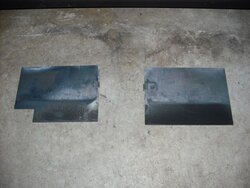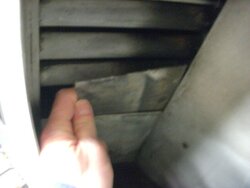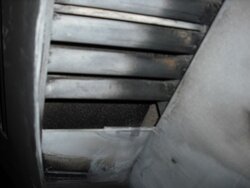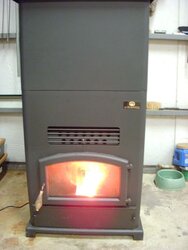I'm pretty disappointed with my new Big E and the local Farm and Home store I purchased it from has not been a lot of help. I apologize in advance for the lengthy post, but I want to include as much information up front as possible. The following is what I submitted to Breckwell including their replies.
*******
I purchased the Big E pellet stove Saturday to replace an old Ashley wood stove that was doing an adequate job of heating my shop. I have been extremely disappointed with the heat output of the Big E stove and initially thought my expectations were too high. After speaking with the dealer and several acquaintances that own pellet stoves, I now believe the stove has a problem.
The pellets are apparently feeding OK (80 pounds per day on setting 4) but the output temperature at the vent averages 105 degrees F (wife's hair dryer puts out more heat). Ambient air temperature has averaged about 12 degrees over outside temperature (25 to 40 degrees since Saturday). The flue gas temperature is over 200 degrees which doesn't seem to be the 80+% efficiency advertised. The flame is not near as large as what is depicted on your web site, 5 to 6 inches over the burn pot on the average. I have tried various damper settings to no avail. The pellets are the same brand a friend is using in a smaller stove at a lower setting with about a 200 degree temperate output.
My 2400 sq. ft. building is air tight and insulated. I realize this is a little larger than the stoves rating but I am not expecting 70 degree temperatures. My old Ashley would easily maintain 30 degrees above outside temperature and much more if I fired it a little harder (the Ashley was not huge, it was the type found in many living rooms in the 70's and 80's).
The dealer is a Farm and Home store whose knowledge apparently does not go beyond convincing customers how great and economical pellet stoves are, so I'm looking forward to hearing from someone that can help me and prove the salesman correct.
********
Breckwell's reply (abbreviated):
I am sorry to hear about your frustrations. This type of compliant usually has a simple explanation.
The first thing I want to you to look at is the slide switch at the top of the control panel. Assuming you are not using an external thermostat this switch should be in “Manual”. If this switch is not in “Manual” then you will get low heat output.
If this is not the case please read further.
You have provided some useful information, however, a few details seem to be missing. You mention feed rates and heat output but you do not mention what heat level you are using. I will provide you the feed rates for each setting so that you can time them independently to verify that the unit is feeding the correct amount of pellets for each setting.
The next question I have is about your exhaust configuration. The units efficiency will greatly depend on the installation. The unit operates best with a simply “out and up” exhaust. If that “up” portion is significantly long then this can create a very power draft and pull heat from the unit and put it out the exhaust. How is your unit exhausted? Mentioning horizontal and vertical feet is important. I am looking for a description that includes the number of feet (or inches) between the stove and the first elbow (or T) and the amount of feet between each elbow and so forth.
Also, you mentioned that the area being heated by the unit is fairly well insulated and air tight. This will probably make have a fresh air intake a must. As the unit draws in fresh air for the combustion process it dumps that air outside via the exhaust. In other words it is constantly removing air form the room it is in if it is draw inside air. This creates a draw against the stove and can greatly affect the heat out and efficiency of the unit.
Lastly, I would like to know about the appearance of the flame. Does it lean over in any direction or does it stand straight up? Is it more orange or more yellow in color?
***********
My response:
The switch is and has been in the manual position.
I have had the heat setting on 4 and the feed rate appears to correspond to the information provided.
The flue gas is exhausted directly out the back with an 18 inch horizontal run of 3" Simpson Duravent terminating with a rain hood. No elbows. The dealer said this would be fine as the stove has a forced draft configuration and does not rely on a natural draft that a vertical run would provide.
When I mentioned the building being airtight, I was mainly implying that I am not heating a drafty, old barn. The building is fairly well sealed but I feel that I'm getting enough fresh air around the overhead door, windows, etc. I could also crack a window an inch or so if you think it will help. At this point I am reluctant to cut any more holes in my walls for additional piping because as it stands, I can not keep this stove and may have to go back to burning firewood (I have water lines to protect from freezing).
I would call the flame a light orange and it has a tendency to lean to the right. I have not had any real soot issues, I have just had to wipe a little ash off of the window now and then.
***********
And Breckwell's latest reply:
I am going to send you some Flue Plates. These plates go in the upper left and right hand corners I “shelves”. The clips will be towards you to hold them there so they don’t fall behind the firewall. The one with the notch cut out of it goes in the left side. (This should make more sense when you receive the plates)
It sounds like the draft through your unit is a little too fast (flame leaning to the right, hot exhaust). These plates are designed to slow the air flow just a bit to help the heat transfer process.
This should solve your problem. I invite you to contact me again if needed to ensure the plates are install properly and so forth.
************
This retrofit sounds like a design flaw and cause for replacement to me. Has anyone run across this before?
I am new to pellet stoves and new to this Forum, but from what I have read, there is a tremendous amount of knowledge here so I thought I would ask for some insight. Thanks in advance.
Roger
*******
I purchased the Big E pellet stove Saturday to replace an old Ashley wood stove that was doing an adequate job of heating my shop. I have been extremely disappointed with the heat output of the Big E stove and initially thought my expectations were too high. After speaking with the dealer and several acquaintances that own pellet stoves, I now believe the stove has a problem.
The pellets are apparently feeding OK (80 pounds per day on setting 4) but the output temperature at the vent averages 105 degrees F (wife's hair dryer puts out more heat). Ambient air temperature has averaged about 12 degrees over outside temperature (25 to 40 degrees since Saturday). The flue gas temperature is over 200 degrees which doesn't seem to be the 80+% efficiency advertised. The flame is not near as large as what is depicted on your web site, 5 to 6 inches over the burn pot on the average. I have tried various damper settings to no avail. The pellets are the same brand a friend is using in a smaller stove at a lower setting with about a 200 degree temperate output.
My 2400 sq. ft. building is air tight and insulated. I realize this is a little larger than the stoves rating but I am not expecting 70 degree temperatures. My old Ashley would easily maintain 30 degrees above outside temperature and much more if I fired it a little harder (the Ashley was not huge, it was the type found in many living rooms in the 70's and 80's).
The dealer is a Farm and Home store whose knowledge apparently does not go beyond convincing customers how great and economical pellet stoves are, so I'm looking forward to hearing from someone that can help me and prove the salesman correct.
********
Breckwell's reply (abbreviated):
I am sorry to hear about your frustrations. This type of compliant usually has a simple explanation.
The first thing I want to you to look at is the slide switch at the top of the control panel. Assuming you are not using an external thermostat this switch should be in “Manual”. If this switch is not in “Manual” then you will get low heat output.
If this is not the case please read further.
You have provided some useful information, however, a few details seem to be missing. You mention feed rates and heat output but you do not mention what heat level you are using. I will provide you the feed rates for each setting so that you can time them independently to verify that the unit is feeding the correct amount of pellets for each setting.
The next question I have is about your exhaust configuration. The units efficiency will greatly depend on the installation. The unit operates best with a simply “out and up” exhaust. If that “up” portion is significantly long then this can create a very power draft and pull heat from the unit and put it out the exhaust. How is your unit exhausted? Mentioning horizontal and vertical feet is important. I am looking for a description that includes the number of feet (or inches) between the stove and the first elbow (or T) and the amount of feet between each elbow and so forth.
Also, you mentioned that the area being heated by the unit is fairly well insulated and air tight. This will probably make have a fresh air intake a must. As the unit draws in fresh air for the combustion process it dumps that air outside via the exhaust. In other words it is constantly removing air form the room it is in if it is draw inside air. This creates a draw against the stove and can greatly affect the heat out and efficiency of the unit.
Lastly, I would like to know about the appearance of the flame. Does it lean over in any direction or does it stand straight up? Is it more orange or more yellow in color?
***********
My response:
The switch is and has been in the manual position.
I have had the heat setting on 4 and the feed rate appears to correspond to the information provided.
The flue gas is exhausted directly out the back with an 18 inch horizontal run of 3" Simpson Duravent terminating with a rain hood. No elbows. The dealer said this would be fine as the stove has a forced draft configuration and does not rely on a natural draft that a vertical run would provide.
When I mentioned the building being airtight, I was mainly implying that I am not heating a drafty, old barn. The building is fairly well sealed but I feel that I'm getting enough fresh air around the overhead door, windows, etc. I could also crack a window an inch or so if you think it will help. At this point I am reluctant to cut any more holes in my walls for additional piping because as it stands, I can not keep this stove and may have to go back to burning firewood (I have water lines to protect from freezing).
I would call the flame a light orange and it has a tendency to lean to the right. I have not had any real soot issues, I have just had to wipe a little ash off of the window now and then.
***********
And Breckwell's latest reply:
I am going to send you some Flue Plates. These plates go in the upper left and right hand corners I “shelves”. The clips will be towards you to hold them there so they don’t fall behind the firewall. The one with the notch cut out of it goes in the left side. (This should make more sense when you receive the plates)
It sounds like the draft through your unit is a little too fast (flame leaning to the right, hot exhaust). These plates are designed to slow the air flow just a bit to help the heat transfer process.
This should solve your problem. I invite you to contact me again if needed to ensure the plates are install properly and so forth.
************
This retrofit sounds like a design flaw and cause for replacement to me. Has anyone run across this before?
I am new to pellet stoves and new to this Forum, but from what I have read, there is a tremendous amount of knowledge here so I thought I would ask for some insight. Thanks in advance.
Roger







